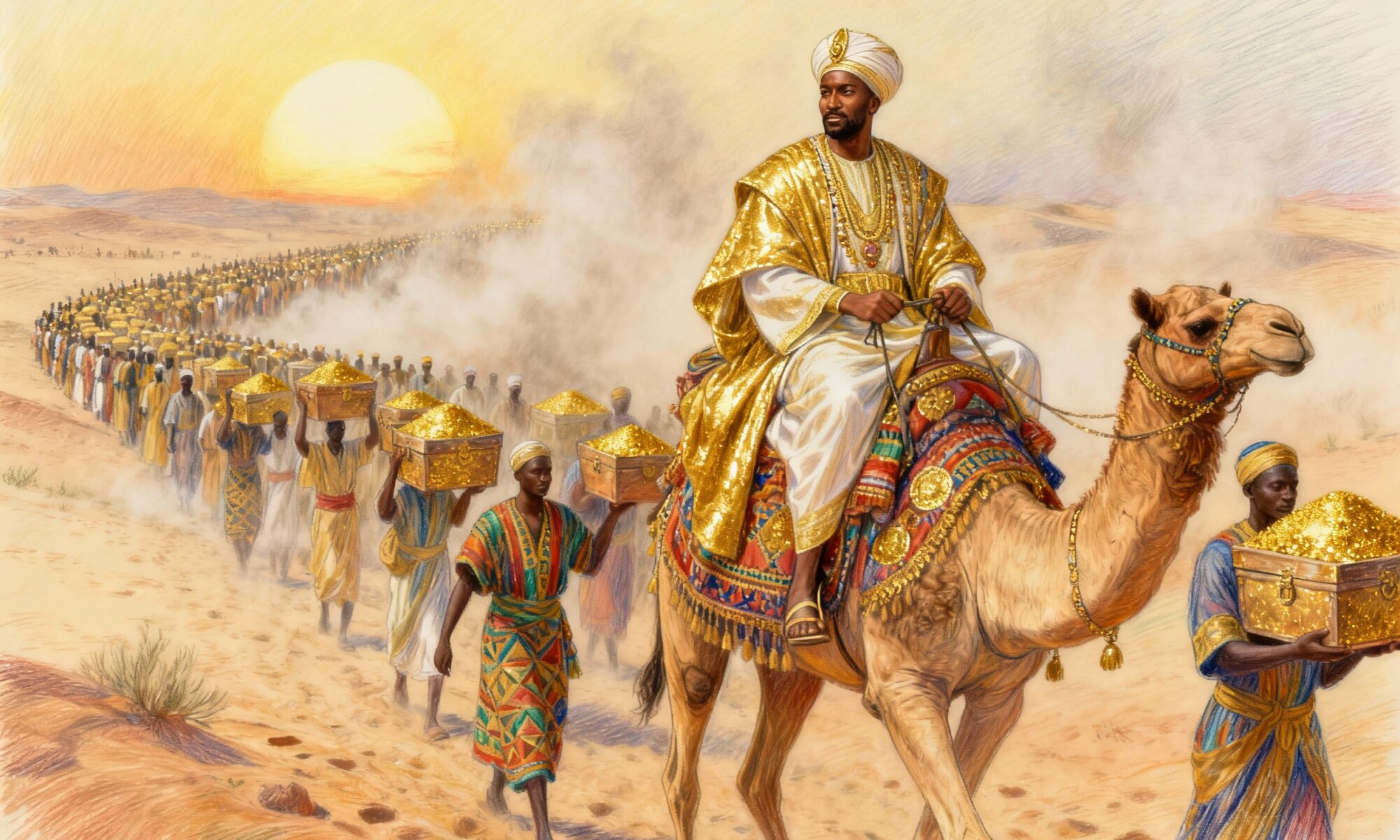Who Was the Golden King?
Before the journey, there was the man. Mansa Musa, whose name means “Emperor Musa”, ascended to the throne of the Mali Empire around 1312 CE. He wasn’t some minor chieftain; he was the ruler of a sprawling, sophisticated empire that stretched for over 2,000 miles across West Africa, encompassing modern-day Mali, Senegal, the Gambia, Guinea, and parts of Mauritania and Niger.
The source of Mali’s incredible wealth was its near-total control over the region’s most valuable resources: salt and, most importantly, gold. The empire sat atop some of the richest gold mines the world has ever known, including the legendary mines of Bambuk and Wangara. At a time when gold was in high demand across Europe and the Middle East, the Mali Empire held what is estimated to be nearly half of the Old World’s entire supply. Mansa Musa was, by any measure, the richest person on Earth.
A Caravan of Unimaginable Scale
As a devout Muslim, fulfilling the Hajj—the pilgrimage to the holy city of Mecca—was a sacred duty for Mansa Musa. But for an emperor of his stature, this was no ordinary trip. He planned a procession designed to showcase the immense piety, power, and prosperity of his empire.
The scale of his caravan, as documented by contemporary Arab historians like Al-Umari, is almost difficult to comprehend:
- A procession of 60,000 people, including a 12,000-strong personal retinue of servants and slaves.
- A dedicated military force of soldiers to provide security across the vast Sahara Desert.
- His wife, the empress Inari Konte, with her own retinue of 500 serving women.
- A train of 100 camels, each carrying around 300 pounds of pure gold dust.
- Thousands of other camels carrying food, supplies, and fine silks for the thousands-strong entourage.
- Most famously, 500 slaves marching ahead of the Mansa, each carrying a staff made of solid gold weighing approximately 4 pounds.
This wasn’t just a caravan; it was a mobile golden city snakeing its way across Africa. Eyewitnesses described the emperor himself on horseback, preceded by his gold-staff-bearing slaves, dazzling all who saw him.
Making It Rain Gold in Cairo
The journey of nearly 4,000 miles was an epic in itself, but the caravan’s stop in Cairo in July 1324 became the stuff of legend. The arrival of this golden army stunned the citizens and officials of the Mamluk Sultanate, then the dominant power in the Middle East.
Initially, Mansa Musa, viewing himself as a humble pilgrim, was reluctant to meet with the Sultan of Egypt. However, protocol demanded it. Upon meeting, he lavished gifts upon the Sultan’s court and officials. But his generosity didn’t stop there. He distributed gold freely to the poor, to merchants, and to religious scholars. He spent so lavishly, giving away handfuls of gold dust to anyone he met, that his actions had an immediate and catastrophic economic effect.
By flooding the Cairene market with an unprecedented amount of gold, Mansa Musa single-handedly caused the value of gold to plummet. The price of the gold dinar crashed, and according to Al-Umari, the market didn’t recover for over a decade. Imagine one man’s generosity being so profound that it devalued a major city’s core measure of wealth for 12 years. On his return journey, it’s said that Musa attempted to rectify the situation by borrowing back gold from Cairene merchants at exorbitant interest rates, the first and only time in history a man tried to prop up a foreign market he himself had crashed.
Putting Mali on the World Map
Before Mansa Musa’s Hajj, European knowledge of the African interior was a tapestry of myth and speculation. It was often referred to as a “benighted” land of mysterious creatures and little of substance. Musa’s pilgrimage shattered that perception forever.
News of the golden emperor of Mali spread like wildfire through the merchant routes of the Mediterranean and into Europe. Suddenly, this distant kingdom was not a place of fantasy but a very real center of unimaginable wealth and power. This new awareness was immortalized in one of the most important maps of the medieval period: the 1375 Catalan Atlas.
The atlas, a key navigational tool for sailors, prominently features West Africa. And there, seated on a throne in the middle of the continent, is a depiction of a Black king wearing a golden crown, holding a golden scepter in one hand and a giant golden nugget in the other. The caption leaves no doubt: “This Black lord is called Musa Mali, Lord of the Blacks of Guinea. So abundant is the gold which is found in his country that he is the richest and most noble king of all the land.”
Mansa Musa had literally put his empire on the map.
The Golden Legacy
Mansa Musa’s pilgrimage was more than just the world’s most extravagant road trip. It was a strategic investment in his empire’s future. He returned to Mali not just with his religious duties fulfilled, but with an entourage of the Islamic world’s brightest minds: scholars, poets, astronomers, and architects, including the famed Andalusian architect Abu Ishaq al-Sahili.
This influx of talent kickstarted an architectural and intellectual renaissance in Mali. Al-Sahili was commissioned to build magnificent mosques and learning centers, most notably the legendary Djinguereber Mosque in Timbuktu, a structure still standing today. Under Musa’s patronage, Timbuktu and its University of Sankore were transformed into one of the world’s great centers of learning, drawing scholars from across the Muslim world.
Mansa Musa’s journey was an act of faith, a statement of power, and a catalyst for cultural transformation. He demonstrated that West Africa was not on the periphery of the medieval world, but a vital and brilliant center in its own right. His story reminds us that history’s greatest figures can come from any corner of the globe, and that a single journey can, quite literally, change the world.
